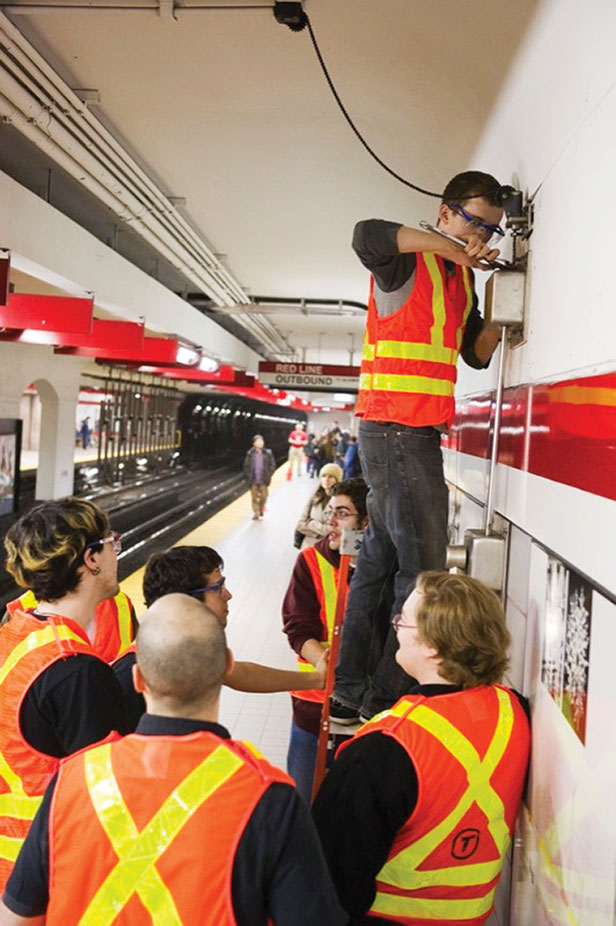And the Band Played On
MIT students go underground to give the T’s Kendall Band new life
The T station at Kendall/MIT fills with the screech of an approaching train. As the doors open, riders spill onto the platform, and a small girl runs straight for a long silver lever mounted on the station wall. She pushes and pulls on the handle with a frenzy.
“You need to go slow,” says her mother. “You’ve forgotten—we haven’t done this in a while.”
At her mother’s suggestion, the girl slowly works the lever back and forth, and large mallets, suspended above the tracks, respond by swinging between heavy aluminum pipes. As the mallets make contact, the echoes of the departing train are replaced by the deep, mellow sound of bells.
This story is only available to subscribers.
Don’t settle for half the story.
Get paywall-free access to technology news for the here and now.
Subscribe now
Already a subscriber?
Sign in
The musical contraption is part of the Kendall Band, a three-instrument sculpture built in the late 1980s by the artist Paul Matisse, grandson of the renowned French painter Henri Matisse. The bells are named after the Greek philosopher Pythagoras. The second instrument, Kepler, is a 125-pound metal ring, suspended under a huge hammer. The last, Galileo, is a large, thunderous sheet of hanging metal.
Each instrument is “played” by working corresponding levers, and through the years, enthusiastic players wore down the instruments so much that Matisse had to make regular trips to Cambridge to repair damaged parts. The aging artist eventually grew weary of the upkeep, and the instruments fell into disrepair.
On a tip from a Kendall Band fan, MIT took up the cause in November 2009. Clarise Snyder, director of the MIT Concerts Office, approached Michael Tarkanian ‘00, SM ‘03, technical instructor in materials science and engineering, with the idea of restoring the instruments. Tarkanian assembled around 20 music and engineering students, who dubbed themselves the Kendall Band Preservation Society, and in April 2010, after taking an MBTA safety training course, the team started to dismantle and refurbish Pythagoras.
There was just one hiccup: Matisse had lost all his original blueprints, so the team had to keep detailed records as they took the instrument apart, nut by bolt.
“The first night we came out to take the handles down, we didn’t even know what size wrenches and sockets we needed,” says Tarkanian. “So we brought everything.”
For two nights in July, when the Red Line shut down between 1:30 a.m. and 4:30 a.m., teams of students scaled ladders between subway platforms, working methodically to take down each pipe and pendulum.
Over the course of the school year, the students built a lathe to mount the pipes, polished away years of grit and grime, and coated the pipes with a protective finish. They also replaced corroded bolts and springs, as well as rubber pads on each mallet.
Along the way, they took scrupulous notes, recording the dimensions and layout of each part, and they plan to re-create the structure in CAD. Tarkanian is now working with Matisse on a maintenance document for future caretakers—a “sort of step-by-step IKEA instruction manual” spelling out the specific tools and parts needed to preserve the instrument.
The students finished restoring Pythagoras in April, just in time for MIT’s Open House; Kepler and Galileo restorations were slated to begin over the summer. To commemorate the restoration, the Music and Theatre Arts Section will hold an annual composition competition. The student with the winning musical score—for Pythagoras plus one other instrument—will perform the piece at the end of each school year.
To make sure Pythagoras is up to the yearly challenge, Tarkanian has made a small adjustment to his evening commute.
“I used to get on the train right at the entrance,” he says. “But now I get on further down, and as I walk by, I check out the handles to see if something has come loose. And that seems to work.”
